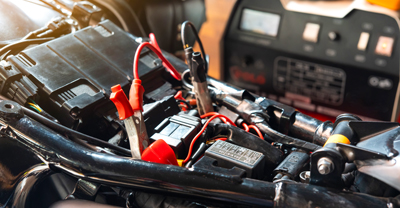How to choose a commuter motorcycle


0 min. read
When you’re shopping for a motorcycle, it’s tempting to focus on the flashiest qualities—speed and style. But, if you’re looking for a daily commuter, there are other things to consider.
What does your commute look like?
Your commute will influence what you look for in a motorcycle. A 30-mile commute on rural highways and backroads will put different demands on your motorcycle than a 10-mile commute through a dense city.
Distance of your commute

If your commute is on the longer side—either in time or distance—you may want to prioritize fuel efficiency, built-in storage, and comfort features like better seat padding and wind screens.
With a shorter commute, you can prioritize a lighter, slimmed down bike that’s easier to maneuver in traffic and tight city streets.
City or highway commute

The low speeds and frequent stop-and-go driving of a city commute can cause your motorcycle engine to run hot. Many modern motorcycles with air-cooled engines perform much better than their earlier counterparts, but liquid-cooled engines are even better at maintaining a consistent temperature. However, they’re more complex and can be expensive to repair.
Highway speeds will ensure constant airflow to the engine, but also come with wind resistance. Consider a bike with fairings to help shield you from the wind and weather and make you more aerodynamic.
Weather on your commute

If you live in a cold climate, you’ll find features like heated grips and snow-rated tires useful in a commuter. You can also use oil and coolant in your bike that are rated for cold temperatures. Mostly though, your success and comfort in the elements will depend on your experience and your cold weather riding gear.
High temperatures can be just as tricky for motorcycles as the cold. The risk of your engine overheating increases when temperatures exceed 90° F (32° C). If you have an air-cooled engine, you can help it stay cool by limiting your idling time and by lane splitting where it’s safe and legal.

What types of bikes are commonly used as commuters?

Motorcycles come in a range of styles, but a daily commute can put stress on both the bike and your body. The right commuter bike will be well equipped to handle both.

Standard motorcycles
Standard motorcycles feature an upright seating position with handlebars placed at a comfortable distance, promoting a relaxed riding posture.
They typically also have less-powerful engines than a sport bike or chopper, which is great for fuel economy and maneuverability.

Naked bikes
Naked bikes support the same upright riding posture as standard motorcycles but are stripped down of any fairings and typically don’t have a windscreen. Their smaller size and weight help them navigate traffic, make them easier to manhandle, and take up less storage space.

Sport touring/upright sport/adventure tourer motorcycle
These types of bikes are called by several different names, partly because it’s a midway point between two types of motorcycle. They're optimized for performance like sport bikes and offer the long-distance abilities and seat comfort of touring motorcycles.
While these motorcycles lack the agility of the best sport bikes and the extra storage of touring bikes, they more than make up for it with their versatility.

Scooters and mopeds
While not as popular in the United States, many people across the globe rely on scooters and mopeds for commuting, and with good reason. They’re small and easy to maneuver, have awesome fuel efficiency, and are relatively inexpensive.
For all their pros, scooters and mopeds aren’t the best on long commutes. Scooters have smaller engines than other commuting options—usually 50cc–300cc—which can make the engine work harder to reach and maintain highway speeds. They’re also less comfortable over long distances than motorcycles.
What makes a motorcycle a good commuter?
If you’re still looking to narrow down your choices when finding a commuter motorcycle, consider these criteria:
Motorcycle specifications
If you’re a seasoned rider, there’s a lot to be said for sticking with what you’re used to riding.
If you’re starting fresh or looking for something new, take a look at recent popular commuter bike lists. Many of the bikes are slimmed down machines that prioritize consistency and maneuverability over power. That generally means bikes at or below 500 pounds with minimal fairings for a compact footprint.
Also consider purchasing a motorcycle with an automatic transmission, especially if you’re commuting in the city.
Motorcycle comfort
Along with making your commute a pleasant experience, being comfortable can help you stay focused and alert on the road.
Here are some qualities that can make or break your comfort:
Seating position
Seat cushion
Handlebar position
Seat height
Fairings and windscreens
Motorcycle safety
You’re going to ride this motorcycle daily, so it should be as safe as possible. A lot of motorcycle safety comes from wearable gear and experience, but it’s a good idea to pick up a commuter equipped with these features:
Anti-lock braking system (ABS)
LED headlights and taillights so you can see and be seen on the road
Motorcycle fuel efficiency
Motorcycles are already a step in the right direction for fuel-efficient commuter vehicles, but some motorcycles get better gas mileage than others.
One of the main indicators is engine size, but it’s not a direct correlation. Smaller engines typically use less fuel than large engines, but if you don’t have enough power, the engine will have to work harder to perform the same tasks, using more fuel in the process.
Your tire pressure, cargo weight, and throttle control can also alter a bike’s fuel economy. But when you balance power and utility, your commuter motorcycle will perform closest to its advertised MPG.
Motorcycle storage
Storage may not be the first thing you look for when buying a motorcycle, but your daily commute can come with a lot of stuff—your laptop, gym gear, the quick grocery stop you make on the way home, and more.
Some motorcycles have built-in storage, but it’s most common on touring bikes, which are larger than the typical commuter. You can also invest in aftermarket storage options like saddlebags, but make sure you consider how the weight will affect the balance of your motorcycle.
Most popular commuter motorcycles of 2024
You can find Top 10 Commuter Motorcycle lists and discussions all over the internet. They’re compiled annually by brands, publications, and even forum websites like Reddit. Here are some options to peruse from the biggest names in the industry.

Look no further! Get a free motorcycle insurance quote today.
Related resources
The general information in this blog is for informational or entertainment purposes only. View our blog disclaimer.










